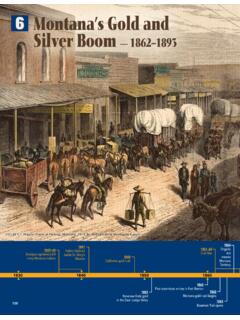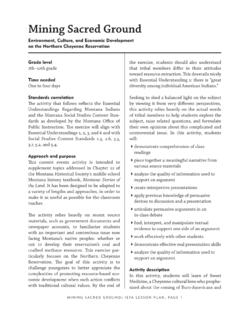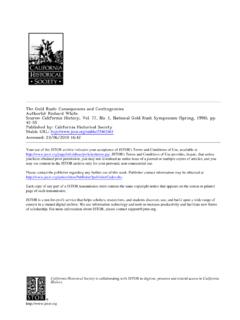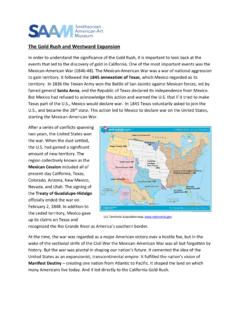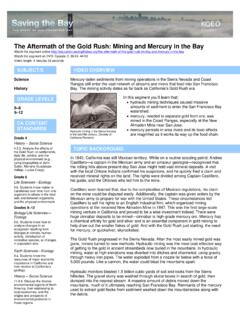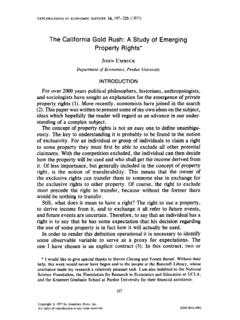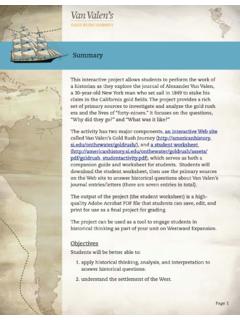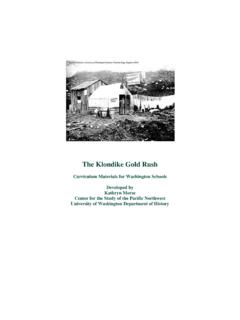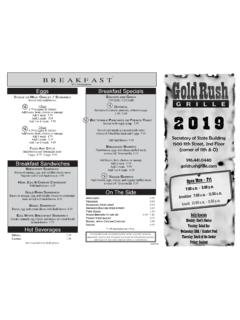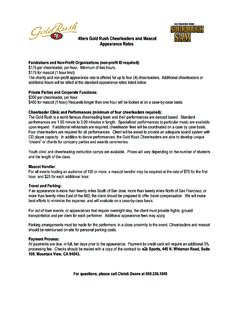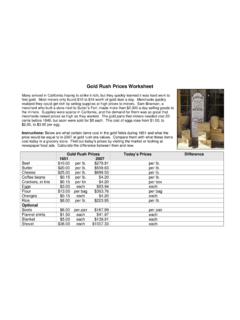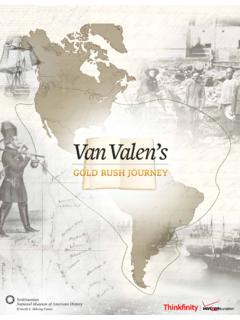Transcription of 1860 - Montana
1 1001861 65 Civil War1852 Benetsee fi nds goldin the Deer Lodge Valley1837 40 Smallpox epidemics kill many Montana Indians1841 Father DeSmetbuilds St. Mary s Mission1860 First steamboat arrives in Fort Benton1848 California gold rush1862 Montana gold rush begins1863 Bozeman Trail opens1864 OrganicActcreatesMontanaTerritoryFIGURE : Wagon Trains at Helena, Montana , 1874, by William de la Montagne Cary18601850184018304 N E W C O M E R S E X P L O R E T H E R E G I O N 1 0 11880 First train entersMontana Territory101Of all the words spoken throughout Montana s past, you could say that one word has changed the landscape more than any other: gold !
2 The discovery of gold in Montana in the 1860s brought thousands of people of many cultures and backgrounds to the Rocky Mountains. These newcom-ers held different beliefs than the people who lived here. They had a different economy based on gold instead of furs or trade goods and they used differ-ent methods of transportation. They brought fears and expectations that they had formed long before they got here. They imposed their ideas on the land and on one another. They also adapted to their new land, just as everyone throughout time has done. The discovery of gold changed the landscape of Montana . Mines multiplied in the gulches.
3 Towns sprang up nearby. Farms spread through the valleys. Ancient trails and pathways became wagon roads. gold also created a new economic pattern in Montana : the boom-and-bust cycle. Each gold discovery brought sudden activity followed by decline, then a period of quiet, and then a sudden burst of activity again in another lo-cation. This boom-and-bust cycle defi ned Montana s economy during the gold rush Era, and it continued to shape life in Montana and all across the West for the next 100 Big Picture gold discoveries triggered a fl ood of new people into Montana . They used and thought about the land in an entirely different way than the Indian tribes who had made their homes here for thousands of years.
4 READ TO FIND OUT: How new ideas change the landscape How the gold rush changed Montana The difference between placer mining and quartz mining Why mining camps needed to establish Montana Territory1874 Silver boom beginsin Montana1883 Northern Pacifi c Railroadcompletes transcontinental route1883 Fewer than 200 bison remain on the Plains1876 Battle of the Little Bighorn1869 First transcontinentalrailroad completed1874 87 Indian reservationsmade smaller1879 Edison patentslong-lastinglight bulb1883 Copper boom begins in Butte1889 Montana becomesa state1893 Panic of 1893 and collapse of the silver market18701880189019001 0 2 P A R T
5 2 : A C E N T U R Y O F T R A N S F O R M A T I O NFirst gold rush in the West: California, 1848 The fi rst gold rush in the West started in California in 1848. One man discovered gold at Sutter s Mill, and nearly 250,000 people dashed to California to seek their fortunes. The pattern repeated across the West. Prospectors (people who search for gold ) usually young, eager, restless men fanned out into the creeks and gulches of mountain ranges. Merchants and farmers rushed in after the miners to sell them supplies, food, and mining equipment. Each major gold strike triggered a new wave of people. Prospectors worked an area until it played out (no longer yielded gold ) and quickly moved on.
6 By the 1850s some of them had made their way to Major Strikes in MontanaIn the early 1850s a fur trapper called Benetsee (his M tis name was Fran ois Finlay) discovered a small amount of gold in the Deer Lodge Valley not much, but enough to start people talking. A few years later, brothers Granville and James Stuart found gold nearby. But they ran out of salt and lost four horses in a Blackfeet raid, so they decided to keep moving. When they returned, they staked a claim on a spot they named gold Creek and wrote to their brother in Colorado, urging him to come north. No gold discovery remained a secret long.
7 That letter sparked a small stampede into Creek Made the City of BannackOn a hot July day in 1862, a prospector named John White and his part-ner William Eads found gold along a tributary of the Beaverhead River (in southwest Montana ). The grasshoppers were so thick that the miners named it Grasshopper Creek. Their excitement attracted miners from the whole region. Four hundred people fl ocked to the scene that summer. Soon miners had marked out and claimed the entire length of Grasshopper Creek. They built a little town and named it Bannack City after the nearby Bannock Indians. By the following April, 1,000 people lived there.
8 Grasshopper Creek produced $5 million in gold dust (worth $90 mil-lion today) in its fi rst year. It also produced some outrageous rumors. Some said they could pull up a sagebrush plant, shake the roots out over a pan, and collect a dollar s worth of like this lured all sorts of people with high expectations. They FIGURE : One of Montana s fi rst gold camps, the town of Pioneer City grew up to supply and support the prospec-tors and miners around gold Creek in the Deer Lodge Valley. Like many gold camps, it was quickly abandoned when the gold played that mining required endless toil in harsh weather grueling labor even to men used to hard work, as prospector Ed Morsman wrote in a letter to his family in spent all they earned just to get by, or arrived at a discovery too late to stake a good claim.
9 As James Morley wrote in his diary in 1863, Labor is abundant and many are disappointed. These disap-pointed latecomers fanned out across the landscape, seeking their own bonanza (rich mineral deposit). Alder Gulch: Almost an AccidentIn May 1863 two prospecting parties left Bannack to search for gold in the Yellowstone River region. This was Crow territory. The Crow had little patience for gold prospectors because they trespassed on Crow land but offered nothing of value to trade. They chased off the fi rst group. When they met the second party of prospectors, the Crow took their horses and equipment, turned them around, and sent them back where they came from.
10 This second party included a man named Bill Fairweather. On their way back to Bannack, Fairweather and his companions camped along a stream in the Ruby River Valley that was tangled with alders (thick bushes). After supper Fairweather scratched at the bedrock with his pocket knife to see if he could fi nd enough money to buy a little to-bacco. Moments later he shouted out, I ve found a scad! A scad meant a lot. The next day they recovered $200 worth of gold ($2,900 today). Within a few months thousands of people fl ooded into Alder Gulch to take part in Montana s rich-est gold discovery.
